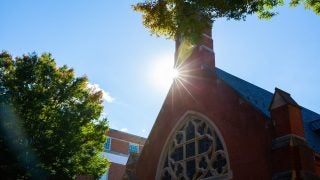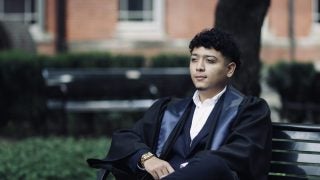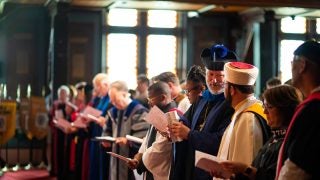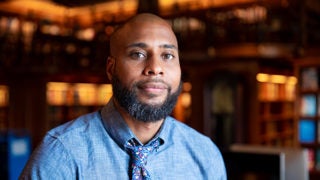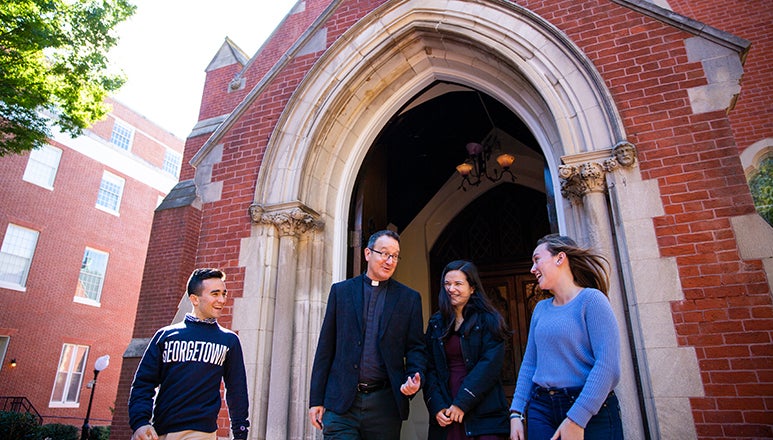
Title: The Jesuit Mission: Seeking God in All Things
Jesuit Values at Georgetown
Have the Jesuits always been educators? How does a Jesuit become a Jesuit? What is cura personalis? Get answers about all things Jesuit here.
The Society of Jesus – or the Jesuits for short – is the religious order of men in the Catholic Church who founded Georgetown along with many other high schools, colleges and universities around the world.
From the beginnings of the Society of Jesus – education, ministry and outreach to the marginalized have been at the core of the Jesuit mission.
Still, many ask: Who exactly are the Jesuits? Who was their founder? How do they fit into the Catholic Church? What is their history? The following sections attempt to answer some of these questions.
What is a Jesuit?
The Jesuits are an apostolic religious community called the Society of Jesus. They are grounded in love for Christ and animated by the spiritual vision of their founder, St. Ignatius of Loyola, to help others and seek God in all things. As members of a worldwide society within the Catholic Church, the Jesuits are committed to the service of faith and the promotion of justice.
When did the Society of Jesus begin?
St. Ignatius created the religious order of men in the Roman Catholic Church in the 16th century. Ignatius and his friends – all of them students at the University of Paris – committed themselves to establishing the Society of Jesus in Montmartre in 1534. They received official recognition as a religious order in the Catholic Church from Pope Paul III in 1540.
Who was Saint Ignatius?
Ignatius was born in the Basque region of Spain in 1491, the youngest son of a minor nobleman. A soldier and courtier in Spain, he was driven by a desire for fame, honor and nobility. While defending a castle in Pamplona against a French siege, however, he was struck by a cannonball that shattered his leg and left him bedridden for months. Out of boredom during his recovery, he turned to the only books available in the castle’s limited library – the life of Christ and the lives of the saints. This resulted in a deep desire to serve God. Ignatius began to travel widely – begging, preaching and caring for the poor and the sick. Along the way, he recorded his spiritual insights and methods of prayer in a manual that later became the Spiritual Exercises. This handbook provides the paradigm for a spirituality and pedagogy that Jesuits and their lay colleagues continue to use to this day.
How did Ignatius develop a following?
During Ignatius’ conversion process, he recognized his lack of formal education and training in the humanities, philosophy and theology. Already in his 30s, Ignatius went to school to pursue an education. While finishing his studies at the University of Paris, Ignatius’ experience of God and his boundless spirit captivated other students. Soon after, in a chapel in Montmartre outside Paris, Ignatius and six of his university friends professed religious vows of poverty and chastity to bind themselves more closely together in their dedication to God and “the betterment of souls.” These companions, who called themselves “friends in the Lord,” would eventually become the first Jesuits, officially known as the Society of Jesus (hence the S.J. behind Jesuits’ last names).
How did the Jesuits become associated with education?
While Ignatius did not direct Jesuits to open schools, he soon discovered how greatly people’s lives could be improved by an education rooted both in gospel values and the humanistic revival of the Renaissance. He began to see the task of education as one of the most important ways of promoting “the betterment of souls.” The Jesuits quickly built a reputation as teachers and scholars. Students from all over Europe flocked to the burgeoning schools, and Jesuit missionaries opened schools where none before had existed. Even prior to the establishment of Georgetown University, the Jesuits were operating more than 800 universities, seminaries and secondary schools around the globe. Many of these schools catered to students who might otherwise not receive a formal education, and the Jesuits committed themselves to educating everyone they could. Ignatius himself spent significant time in his later years fundraising for these schools so that students who could not afford tuition would not be turned away.
How does a Jesuit become a Jesuit?
After entering the Society, men pursue a decade-long course of studies and spiritual formation before being ordained to the priesthood. Many also earn advanced degrees in a wide variety of academic disciplines. The Georgetown Jesuit community has thus been home to actors, astronomers, poets, politicians, playwrights, physicians, lawyers, sculptors, painters and professors of every field. Most but not all Jesuits serve as priests. There are also Jesuit brothers, several of whom live and work here at Georgetown.
How does this tradition continue at Georgetown today?
The spirituality and values of Ignatius and the early Jesuits marked the schools they founded. Thus Georgetown continues to offer its students a distinctive education. Certain characteristics, grounded in the vision of Ignatius and the early Jesuits, are of paramount importance for universities in the Ignatian tradition. St. Ignatius believed that as individuals come to understand the world and develop a more robust vision of it, they are led to think and act in new ways. He understood this integral connection between knowing and acting, and hoped that Jesuits and the graduates of their schools would become “contemplatives in action.” The phrase refers to women and men committed to the service of others and to a faith that does justice in the world. Grounded in a spirituality that seeks to “find God in all things,” the pedagogical approach of Jesuit schools emphasizes an individual agency, while contextualizing it within a broader search for the common good. Peter-Hans Kolvenbach, S.J., superior general of the Society of Jesus from 1983 to 2008, once described four objectives that influenced St. Ignatius and the early Jesuits to become involved in higher education. These directives still determine the work of Ignatian educators today. They strive to:
Provide students with knowledge and skills to excel in whatever field they choose.
Contribute to the education of women and men as good citizens, people of competence, conscience and compassion dedicated to the service of faith and the promotion of justice.
Celebrate the full range of human intellectual power and achievement, viewing reason not as antithetical to faith, but as its necessary complement.
Affirm a Christian understanding of the human person as a creature of God whose ultimate destiny is beyond the human.
What is cura personalis?
During the time of his conversion, Ignatius experienced God not as distant and removed, but as a teacher personally involved in his life. Early Jesuit educators similarly worked to develop a reverent familiarity with their students, which allowed Jesuits to educate them on an individual basis according to the particular needs and gifts of each student. The Latin phrase associated with this Jesuit focus on the individual is cura personalis or “care of the whole person.” Caring for the whole person means knowing the student beyond what a transcript can reveal. In keeping with this age-old tradition, Georgetown faculty and administrators strive to learn about students personally – their backgrounds and life histories, their strengths and limitations, their struggles and hopes. These teachers and mentors seek to build personal, trusting relationships with students so they will feel comfortable asking questions, taking intellectual risks and making mistakes and learning from them.
Who was Georgetown’s founder?
Jesuit principles guided John Carroll when he first announced his plans for Georgetown, plans at once modest and grand. In a letter to friends, dated 1788, he wrote: “We shall begin the building of our Academy this summer. …On this academy is built all my hope of permanency and success to our holy religion in the United States.” Carroll does not have an “S.J.” after his name because Pope Clement XIV suppressed the Society of Jesus in July 1773. It was not until the early 1800s that the Jesuits were restored as a religious order in the Catholic Church. The Jesuit college that Carroll’s imagination framed so long ago still stands as a living tradition of which every Georgetown student is a part. Each student shares in the responsibility for keeping this heritage alive. Georgetown University is not “Jesuit” merely because Jesuits live and work here. Ignatius’ spirituality and mission along with John Carroll’s vision and imagination shape the experience of all Georgetown’s daughters and sons. Finally, in his “Proposals for Establishing an Academy,” Carroll sought to establish a home not just for people of the Catholic faith, but for people from all faith traditions. Carroll makes it clear that Georgetown “will be open to students of every religious profession … [and] will be at Liberty to frequent the Places of Worship and Instruction appointed by their Parents …” This commitment to interreligious understanding and collaboration remains an enduring feature of the Georgetown experience to this day.
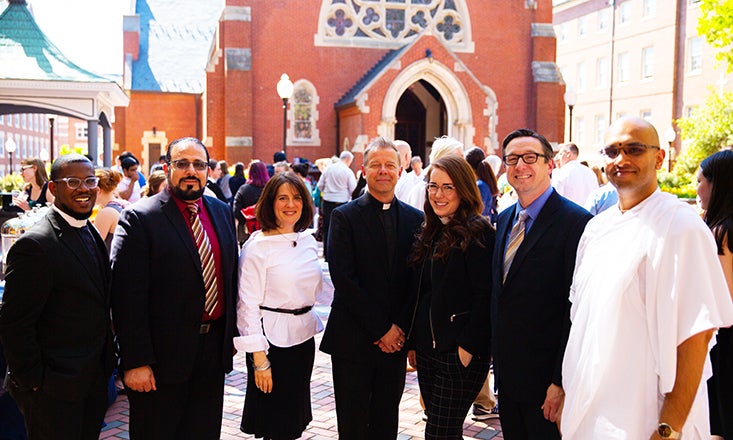
What is the legacy of Jesuits at Georgetown?
Jesuits have cared for the university from its earliest days. Histories of the university celebrate their numerous contributions as teachers, scholars, administrators, chaplains and counselors. Hundreds of Jesuits, along with generous alumni and benefactors, have also worked tirelessly to build Georgetown, both literally and figuratively, into the university it is today. Through the years a significant number of Georgetown alumni have entered the Society of Jesus. Jesuits continue the work of their predecessors, contributing to all aspects of university life. Most of these men live in Wolfington Hall – the Jesuit Residence in Georgetown’s Southwest Quadrangle. Others serve as residential ministers in residence halls. The Jesuit community is led by its local religious superior and is connected to the worldwide Society of Jesus through a regional superior, known as the Provincial. Ultimately, all Jesuits come under the jurisdiction of the Superior General, who resides at the Jesuit headquarters in Rome.
For more information on the Jesuits at Georgetown and around the world, see:
- Banchoff, Thomas and José Casanova, eds. The Jesuits and Globalization: Historical Legacies and Contemporary Challenges. (Georgetown University Press, 2016).
- Brodrick, James. The Origin of the Jesuits. (Image Books, 1960)
- Curran, Robert Emmett. The Bicentennial History of Georgetown University: From Academy to University, 1789-1889. (Georgetown University Press, 1993)
- Durkin, Joseph. Georgetown University: First in the Nation’s Capital. (Doubleday, 1964)
- Lacouture, Jean. Jesuits: A Multibiography. (Counterpoint, 1991)
- Loyola, Ignatius. A Pilgrim’s Journey. Translated by Joseph N. Tylenda. (Michael Glazier, 1985)
- Lucas, Thomas. Landmarking: City, Church and Jesuit Urban Strategy. (Loyola University Press, 1997)
- O’Malley, John W. The First Jesuits. (Harvard University Press, 1993)
- O’Malley, John W. The Jesuits: A History from Ignatius to the Present. (Rowman & Littlefield, 2014)
- Silf, Margaret. Inner Compass: An Invitation to Ignatian Spirituality. (Jesuit Way, 1999)
- Tylenda, Joseph N. Jesuit Saints and Martyrs. ( Loyola University Press, 1984)
